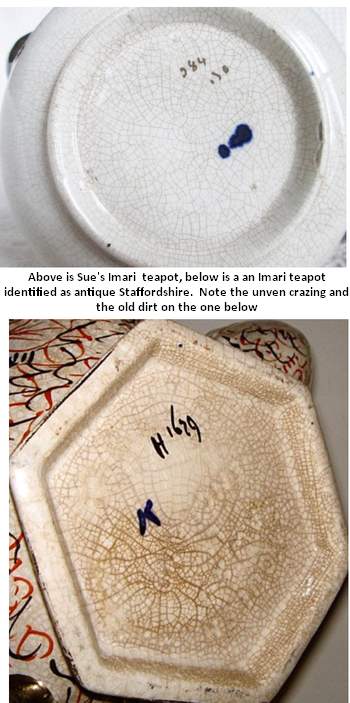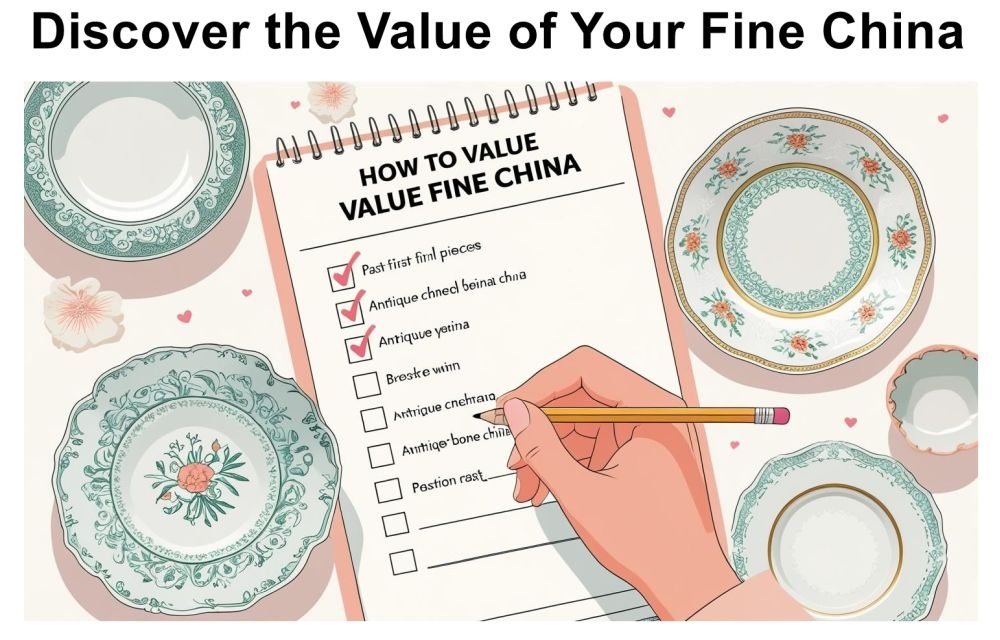My Ornate Teapot With an Exclamation Mark Pottery Marking and Lots of Crazing
by Susan
(New York)

Imari /Arita Teapot
Hi Peter
My biggest challenge is solving the mysteries of some of my pieces.
I know something of backstamps now and can usually identify it and date a piece by it.
This piece I have in mind for your scrutiny is a beautiful teapot with an Imari-inspired palette,and a design that's continuous all the way around.
The only marks on the base are stilt marks, some gold-painted letters and numbers, and an under-glazed blue mark that looks like a fat exclamation point (exclamation mark).
Can't find it anywhere and don't know where else to look.
One dealer thought at first it could be Japanese Imari from pre-WWII, then she checked with a dealer friend, who thinks it is English from the 1800s.
A third dealer couldn't identify it but thought it is very old.
Online research and books have been unavailing so far.
I'm leaning towards English, but it's driving me quietly mad not to know.
If it remains a mystery, I'll live with that and just enjoy the teapot.
Here's some more about me and my interest in collecting and sleuthing.
I am Sue from Brooklyn, NY. But I grew up in a small town upstate. “Old stuff” has always fascinated me – it has an aura one can feel.
Two of my aunts collected china. My mother loved pressed glass. She would take me along to country auctions and to an annual antiques show in a nearby town.
Five decades later, I’m still haunting thrift and antique shops, stoop sales and online sale sites, collecting antique and vintage china because I love it, and love to use it.
Lots of my pieces are English; some are Limoges, Dutch, German/Bavarian, Japanese, or American (my dinner set for six is 1950s Homer Laughlin). It’s fun to learn about them and research their marks. But there are several “mysteries” in my collection, and this is one of them.
As a tea drinker, I’ve collected much tea ware. The minute I saw this teapot on Etsy, I had to have it. It’s delightful and might seem over the top, except that both pattern and pot shape are so beautifully balanced.
It measures 6½” to top of finial, 8½” across from spout to handle. The finial, the notched handle and curved spout (in the photo they appear black) are cobalt blue sponged with gold. The pattern has many different elements, liberally accented with gold.
The painting appears to be done by hand.
The pot has an internal strainer: its holes are somewhat rough and not all perfect circles. It’s in nice condition, except for light staining in crazing (darker on the base, as you see).
The base is unmarked except by stilt marks, a glazed mark which looks like a fat blue exclamation point; and, gold-painted, a backward C with an 84, below it a small dot with a J and a larger dot. I’ve been unable to identify the mark or find a similar pot.
The seller described it as “possibly English” and “Gaudy Welsh?” But although the unknown decorator used the Imari palette, the design here is more elaborate and formal.
At first I thought it might be gilded Gaudy Dutch. It seemed Imari-inspired. So I began buying 20th century English Imari-style tea cups to complement it, and sent a picture of the teapot to one of the sellers to show her how nicely my purchase would go with it. She thought it was gorgeous, said she loves to research and asked for photos of the mark.
She initially thought it is a Japanese Imari pot from the first half of the 20th century. (If so, it wasn’t made for export.) Then she got another dealer involved, and he thinks it’s English from the 1800s. A dealer I know upstate couldn’t identify it, but she too thinks that it’s very old.
Value is the least of my interest in the pieces I collect. My top questions are always
“What is it?”
Who made this pot?
When?
Is it English,
Japanese
or what?
Is it porcelain, or ironstone? (It gives a clunky ring, and it isn’t translucent.)
Is the pot a bell shape?
Does the handle shape have a specific name?
Is this a known pattern, is the pattern under-glazed, or painted polychrome enamel?
I can’t find either my teapot or exclamation mark backstamp, online or in a book.
Without examples, I can’t guess at a possible maker and then try to confirm it.
So I’ve come here: a terrific site where so many fascinating pieces have been posted.
Peter Holland and you who participate in the forum have solved some tough mysteries, and I’m hoping somebody can pull this one out of a hat.
Many thanks for any info or clues!
Thanks for your website, it helps me regularly.
Best wishes
Susan
===================================
Reply by Peter (admin)
Hi Susan
A very nice little article, so full of interesting comments and observations.
We seem to be of a like mind on many things, especially the sleuthing aspects of logical deduction.
Looking at your lovely ornate teapot, my personal view, bearing in mind I don't count myself as an expert, is that this might well be modern, second half of the 20th century and possibly from Japan.
The biggest clue is the Imari style to it, but of course, there are many English makers who also reproduced the Imari type patterns.
So why do I think Japanese?
I may be wrong of course, but the reason I say this are the little clues. First clue is I googled 'fake crazing', and what-do-you-know, up popped my own article about what deliberately manufactured to look old crazing looks like. It covers the surface all over and often has uniformly dark lines (or are uniformly colourless) (use my search box to find the detailed article).
Real crazing (due to age, rather than production) almost ever looks like this. So this crazing looks a lot like like production related rather than age related. Because the crazing is too uniform and too clean for an old Staffordshire teapot, I feel it is more likely mid to late 20th century.
Looka at the comparison between your pot and an old English Imari teapot.

If your crazing is age related, it's weirdly the wrong sort of crazing. Not impossible, but the more unlikely scenario.
Second, I am looking at of the type of décor on the spout and handle (spot-brush dabbing). I have seen this quite a bit on modern Japanese wares (post war), but not that I can recall on English Staffordshire.
This is not to say they didn't do this in Staffordshire or Wales, it's just that I have never noticed it so far. If you were to show me an authentic old Staffordshire item that did have this type of decoration, I would stand corrected, because, like I say, I am not an expert, just an interested observer.
The third little clue is the actual mark itself.
It is very typical of the sort of mark they use in the Far East (particularly Japan) when they are trying to convince consumers the wares were not at all mass produced in the Far East, but European in origin. The whole marking system appears to be trying the emulate the old Staffordshire one seen above. They have done a good job, but your base looks very clean and new in comparison.
You might wonder why they needed to emulate an older style English pot, when Imari is of course Japanese and this is a lovely teapot made in Japan.
But if you were around in the 1960's you will recall there was an association at that time with Japan being cheap the source of cheap & nasty imports. They wanted to distance themselves from this.
I don't know if I am convincing you of my arguments, but I am doing a good job of convincing myself!
I did the best advanced Google search I know to find other marks shaped like and exclamation mark and there is nothing at all.
Inevitably, real marks from older companies will almost certainly have the gravitas to have been recorded somewhere on or offline and there will be some kind of forum or debate going on about them, no matter how small or obscure.
An exclamation shaped mark is fairly easy to track down online. The more modern Far East marks are rarely recorded in pottery mark books or online as they are not an important enough area of research for writers of books.
Therefore, the many unsolved marks of this type are more often, but not always, more modern in origin.
If you have this mark or know anything we don't, r want to comment on any of my points or Sue's, then please post.
If you have photos, send them to me for inclusion and mention they are for this thread.
Unfortunately, I don't yet have the system where commenters can upload photos direct to their post.
peter
@theclayartist.comPeter (admin)
Comments for My Ornate Teapot With an Exclamation Mark Pottery Marking and Lots of Crazing
|
||
|
||
|
||

Inherited a china set?... Download my free 7-point checklist to instantly assess its potential value.
From the Studio
• Peter Holland Posters
• Sculpture Studio







